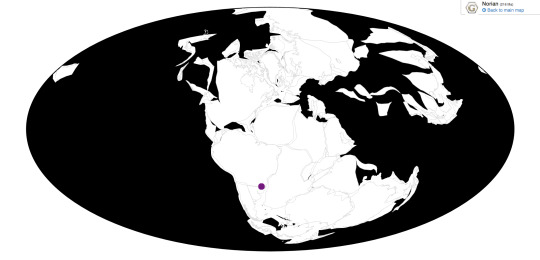#brasilodontid
Text
Brasilodon

By Ripley Cook
Etymology: Brazilian tooth
First Described By: Bonaparte et al., 2003
Classification: Biota, Archaea, Proteoarchaeota, Asgardarchaeota, Eukaryota, Neokaryota, Scotokaryota, Opimoda, Podiata, Amorphea, Obazoa, Opisthokonta, Holozoa, Filozoa, Choanozoa, Animalia, Eumetazoa, Parahoxozoa, Bilateria, Nephrozoa, Deuterostomia, Chordata, Olfactores, Vertebrata, Craniata, Gnathostomata, Eugnathostomata, Osteichthyes, Sarcopterygii, Rhipidistia, Tetrapodomorpha, Eotetrapodiformes, Elpistostegalia, Stegocephalia, Tetrapoda, Reptiliomorpha, Amniota, Synapsida, Eupelycosauria, Metopophora, Haptodontiformes, Sphenacomorpha, Sphenacodontia, Pantherapsida, Sphenacodontoidea, Therapsida, Eutherapsida, Neotherapsida, Cynodontia, Epicynodontia, Eucynodontia, Probainognathia, Chiniquodontoidea, Prozostrodontia, Brasilodontidae
Referred Species: B. tetragonus, B. quadrangularis
Status: Extinct
Time and Place: 227 to 208 million years ago, in the Norian of the Late Triassic.

Take a guess where a synapsid whose name is “Brazilian tooth” was found.

Physical Description: Brasilodon would have looked like a pretty average cynodont in life, because it was. Brasilodon’s skull was wider than deep, as was the case with many cynodonts. Its teeth were distinguished into incisors, canines, and molars. The teeth were small, and the incisors were pointy. The molars were taking on the multicusped shape that modern mammals have, unlike more basal synapsids (which had simple pointy cheek teeth).The teeth were replaced in a polyphyodont manner, where the teeth can theoretically be replaced throughout the animal’s life (unlike most mammals, which get one tooth replacement, and that’s it). Brasilodon’s inner ears indicate a degree of hearing ability close to those of modern mammals, but it lacked the tympanic bone (one of the mammalian ear bones). The rest of the body would have looked rather badgery, with semi-sprawling limbs. Many anatomical details of the postcrania are more similar to those of mammals than other cynodonts. Brasilodon was small, at around 12 cm long, and would have probably been very cute.
Diet: Brasilodon was probably a carnivore. Due to its small size and small, pointy teeth, it may have eaten insects, but its jaw was more resistant to stress than other probainognathians, hinting it may have also taken larger prey.
Behavior: Brasilodon probably had a generalized, adaptable lifestyle. Its forelimbs indicate powerful retractor muscles, but don’t have the same level of robusticity as many burrowing mammals. There are also features of the humerus in common with opossums and primates, and the limbs show a greater degree of flexibility than other probainognathians, which could hint that Brasilodon may have been able to climb. Or… they could just mean nothing; at this size, these adaptations may have been simply to get over irregular, rocky terrain. Nevertheless, burrowing and climbing are both ways to escape potential predators, and climbing could have put Brasilodon in closer proximity to tasty insects.
Ecosystem: Brasilodon was found in the Caturrita Formation of Brazil. In the Triassic, the region was probably fairly arid, with lazy rivers flowing through. There was enough water to support the growth of conifers, at least. This environment was also the home of other cynodonts, such as Brasilitherium, Irajatherium, Minicynodon, and Riograndia, the latter of which was more adapted for burrowing than Brasilodon. Also in this environment lived the sauropodomorph Guaibasaurus, the enigmatic lepidosaur Cargninia, the rhynchocephalian Clevosaurus, and beetles. There was also Faxinalipterus, which was originally described as an early pterosaur, but is probably just some random small reptile.
Other: Brazilodon is one of the very closest relatives of Mammaliaformes (the clade that includes mammals and the very mammaliest synapsids, like Adelobasileus, Morganucodon, and docodonts). Although it has many mammal-like traits, it just wasn’t quite there yet.
~ By Henry Thomas
Sources under the cut
Bonaparte, J.F., Martinelli, A.G., Schultz, C.L. 2005. On the sister-group of mammals: Brasilodon and Brasilitherium (Cynodontia, Probainognathia) from the late Triassic of southern Brazil. Revista Brasileira de Paleontologia 8(1): 25-46.
Guignard, M.L., Martinelli, A.G., Soares, M.B. 2019. The postcranial anatomy of Brasilodon quadrangularis and the acquisition of mammaliaform traits among non-mammaliaform cynodonts. PLoS ONE 14(5): e0216672.
Martinelli, A.G., Bonaparte, J.F. 2010. Postcanine replacement in Brasilodon and Brasilitherium (Cynodontia, Probainognathia) and its bearing in cynodont evolution. In: Calvo, J., Poriri, J., Gonzalez Riga, B., Dos Santos, D. eds. Paleontologia y dinsoaurios desde America Latina. Pp. 179-186.
Salcido, C.J., Rayfield, E.J., Gill, P., Soares, M.B., Martinelli, A.G. 2018. Skull mechanics and functional morpholoy of Brasilodontidae, the sister clade to mammals. Society of Vertebrate Paleontology Annual Meeting, Albuquerque.
Tatarinov, L.P. 2010. On the Origin of the Tympanic Membrane: the Middle Ear of Mammals. Paleontological Journal 44(1): 92-94.
#brasilodon#brasilodontid#probainognathian#cynodont#synapsid#triassic#triassic madness#triassic march madness#prehistoric life#paleontology
152 notes
·
View notes